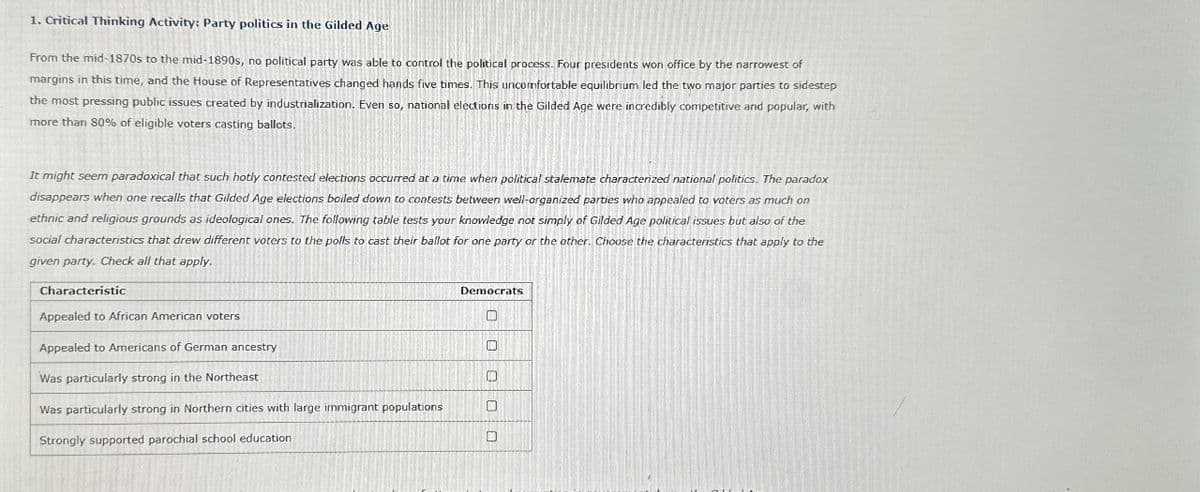1. Critical Thinking Activity: Party politics in the Gilded Age From the mid-1870s to the mid-1890s, no political party was able to control the political process. Four presidents won office by the narrowest of margins in this time, and the House of Representatives changed hands five times. This uncomfortable equilibrium led the two major parties to sidestep the most pressing public issues created by industrialization. Even so, national elections in the Gilded Age were incredibly competitive and popular, with more than 80% of eligible voters casting ballots. It might seem paradoxical that such hotly contested elections occurred at a time when political stalemate characterized national politics. The paradox disappears when one recalls that Gilded Age elections boiled down to contests between well-organized parties who appealed to voters as much on ethnic and religious grounds as ideological ones. The following table tests your knowledge not simply of Gilded Age political issues but also of the social characteristics that drew different voters to the polls to cast their ballot for one party or the other. Choose the characteristics that apply to the given party. Check all that apply. Characteristic Appealed to African American voters Appealed to Americans of German ancestry Was particularly strong in the Northeast Was particularly strong in Northern cities with large immigrant populations Strongly supported parochial school education Democrats 00 000
1. Critical Thinking Activity: Party politics in the Gilded Age From the mid-1870s to the mid-1890s, no political party was able to control the political process. Four presidents won office by the narrowest of margins in this time, and the House of Representatives changed hands five times. This uncomfortable equilibrium led the two major parties to sidestep the most pressing public issues created by industrialization. Even so, national elections in the Gilded Age were incredibly competitive and popular, with more than 80% of eligible voters casting ballots. It might seem paradoxical that such hotly contested elections occurred at a time when political stalemate characterized national politics. The paradox disappears when one recalls that Gilded Age elections boiled down to contests between well-organized parties who appealed to voters as much on ethnic and religious grounds as ideological ones. The following table tests your knowledge not simply of Gilded Age political issues but also of the social characteristics that drew different voters to the polls to cast their ballot for one party or the other. Choose the characteristics that apply to the given party. Check all that apply. Characteristic Appealed to African American voters Appealed to Americans of German ancestry Was particularly strong in the Northeast Was particularly strong in Northern cities with large immigrant populations Strongly supported parochial school education Democrats 00 000
Related questions
Question

Transcribed Image Text:1. Critical Thinking Activity: Party politics in the Gilded Age
From the mid-1870s to the mid-1890s, no political party was able to control the political process. Four presidents won office by the narrowest of
margins in this time, and the House of Representatives changed hands five times. This uncomfortable equilibrium led the two major parties to sidestep
the most pressing public issues created by industrialization. Even so, national elections in the Gilded Age were incredibly competitive and popular, with
more than 80% of eligible voters casting ballots.
It might seem paradoxical that such hotly contested elections occurred at a time when political stalemate characterized national politics. The paradox
disappears when one recalls that Gilded Age elections boiled down to contests between well-organized parties who appealed to voters as much on
ethnic and religious grounds as ideological ones. The following table tests your knowledge not simply of Gilded Age political issues but also of the
social characteristics that drew different voters to the polls to cast their ballot for one party or the other. Choose the characteristics that apply to the
given party. Check all that apply.
Characteristic
Appealed to African American voters
Appealed to Americans of German ancestry
Was particularly strong in the Northeast
Was particularly strong in Northern cities with large immigrant populations
Strongly supported parochial school education
Democrats
Expert Solution
This question has been solved!
Explore an expertly crafted, step-by-step solution for a thorough understanding of key concepts.
This is a popular solution!
Trending now
This is a popular solution!
Step by step
Solved in 3 steps
